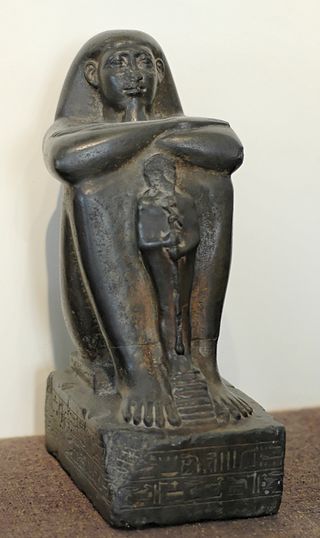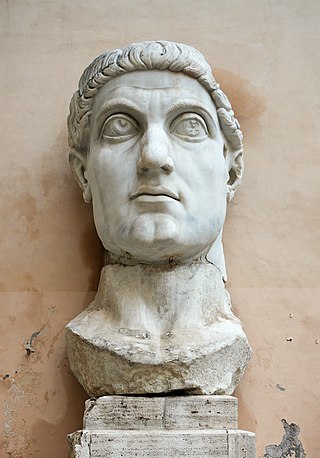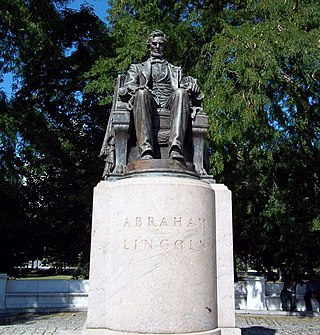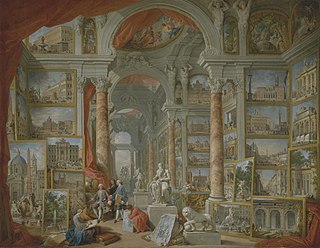
Daniel Chester French was an American sculptor in the late 19th and early 20th centuries. His works include the The Minute Man, an 1874 statue in Concord, Massachusetts, and his 1920 monumental statue of Abraham Lincoln at the Lincoln Memorial in Washington, D.C.

Menkaure or Menkaura was a pharaoh of the Fourth Dynasty of Egypt during the Old Kingdom. He is well known under his Hellenized names Mykerinos, in turn Latinized as Mycerinus, and Menkheres. According to Manetho, he was the throne successor of king Bikheris, but according to archaeological evidence, he was almost certainly the successor of Khafre. Africanus reports as rulers of the fourth dynasty Sôris, Suphis I, Suphis II, Mencherês (=Menkaure), Ratoisês, Bicheris, Sebercherês, and Thamphthis in this order. Menkaure became famous for his tomb, the Pyramid of Menkaure, at Giza and his statue triads, which showed him alongside the goddess Hathor and various regional deities.
The Etruscan terracotta warriors are three statues that resemble the work of the ancient Etruscans, but are in fact art forgeries. The statues, created by Italian brothers Pio and Alfonso Riccardi and three of their six sons, were bought by The Metropolitan Museum of Art between 1915 and 1921.

Ancient Egyptian art refers to art produced in ancient Egypt between the 6th millennium BC and the 4th century AD, spanning from Prehistoric Egypt until the Christianization of Roman Egypt. It includes paintings, sculptures, drawings on papyrus, faience, jewelry, ivories, architecture, and other art media. It was a conservative tradition whose style changed very little over time. Much of the surviving examples comes from tombs and monuments, giving insight into the ancient Egyptian afterlife beliefs.

Kumbo, also known as Kimbo, is the second-largest city in the North West Province of Cameroon and the capital of Bui Division. It lies about 2000m above sea level and is situated approximately 110 km away from Bamenda, on the Bamenda Highlands Ring Road. Kumbo has a population of 80,212 and is split into three distinctive hilly settlements of Tobin, Mbveh, and Squares. The town is known for horse racing and traditional medicine, and also for its palace, a market and two hospitals. Kumbo is the capital city of the Nso Kingdom of the Nso people. The lingua franca is Lamnso but Pidgin, English, Oku, Djottin, Fulfulde, French and Hausa are spoken.

The block statue is a type of memorial statue that first emerged in the Middle Kingdom of Egypt. The block statue grew in popularity in the New Kingdom and the Third Intermediate Period, and by the Late Period, this type of statue was the most common. These statues were used in temples typically as funerary monuments of non-royal yet important individuals. According to primary sources from the New Kingdom, the posture of the statue was possibly intended to resemble a guardian seated in the gateway of a temple. In addition, their simple shape provided ample flat surfaces for inscriptions of offerings and invocations.

Anna Vaughn Huntington was an American sculptor who was among New York City's most prominent sculptors in the early 20th century. At a time when very few women were successful artists, she had a thriving career. Hyatt Huntington exhibited often, traveled widely, received critical acclaim at home and abroad, and won multiple awards and commissions.

Buddhist art is visual art produced in the context of Buddhism. It includes depictions of Gautama Buddha and other Buddhas and bodhisattvas, notable Buddhist figures both historical and mythical, narrative scenes from their lives, mandalas, and physical objects associated with Buddhist practice, such as vajras, bells, stupas and Buddhist temple architecture. Buddhist art originated in the north of the Indian subcontinent, in modern India, Pakistan and Afghanistan, with the earliest survivals dating from a few centuries after the historical life of Siddhartha Gautama from the 6th to 5th century BCE.

The Colossus of Constantine was a many times life-size acrolithic early-4th-century statue depicting the Roman emperor Constantine the Great, commissioned by himself, which originally occupied the west apse of the Basilica of Maxentius on the Via Sacra, near the Forum Romanum in Rome. Surviving portions of the Colossus now reside in the courtyard of the Palazzo dei Conservatori, now part of the Capitoline Museums, on the Capitoline Hill, above the west end of the Forum.
Korean Buddhist sculpture is one of the major areas of Korean art. Buddhism, a religion originating in what is now India, was transmitted to Korea via China in the late 4th century. Buddhism introduced major changes in Korean society. The complexity of the religious sutras sent to Korea required the aristocrats who adopted the religion to become literate and required the training and importation of literate scribes. Little evidence of religious art exists in Korea before the introduction of Buddhism. Subsequent to its introduction, the religion inspired the production of devotional art as well as the beginnings of sophisticated temple architecture.

Abraham Lincoln: The Man is a larger-than-life size 12-foot (3.7 m) bronze statue of Abraham Lincoln, the 16th president of the United States. The original statue is in Lincoln Park in Chicago, and later re-castings of the statue have been given as diplomatic gifts from the United States to the United Kingdom, and to Mexico.

Abraham Lincoln: The Head of State is a 9-foot (2.7 m) tall bronze statue of Abraham Lincoln in Grant Park, in Chicago. Created by Augustus Saint-Gaudens and completed by his workshop in 1908, it was intended by the artist to evoke the loneliness and burden of command felt by Lincoln during his presidency. The sculpture depicts a contemplative Lincoln seated in a chair, and gazing down into the distance. The sculpture is set upon a pedestal and a 150-foot (46 m) wide exedra designed by architect Stanford White.

Picture Gallery with Views of Modern Rome, known simply as Modern Rome, is a trio of almost identical paintings by Italian artist Giovanni Paolo Panini in the 1750s. The original painting shows the arrangement of paintings originally commissioned by Étienne François, Count of Stainville, later the Duke de Choiseul. He was the ambassador to Rome from between 1753 and 1757. In the painting, Stainville is seated on an armchair. Panini created three different versions of this painting. He created two versions of the painting, both dated 1757, for the Count of Stainville – the original is at the Museum of Fine Arts, Boston, while the second is at the Metropolitan Museum of Art in New York. A couple of years later, he created a slightly different version of this painting for Claude-François de Montboissier de Canillac de Beaufort, which now hangs at the Louvre in Paris.

Jain sculptures or Jain idols are the images depicting Tirthankaras. These images are worshiped by the followers of Jainism. The sculpture can depict any of the twenty-four tirthankaras with images depicting Parshvanatha, Rishabhanatha, or Mahāvīra being more popular. Jain sculptures are an example of Jain art. There is a long history of construction of Jain sculptures. Early examples include Lohanipur Torsos which has been regarded to be from the Maurya period, and images from the Kushan period from Mathura.

The Yixian glazed pottery luohans are a set of life-size glazed pottery sculptures of arhats now usually regarded as originating from the Liao dynasty period (907–1125). They were apparently discovered in the early 20th century in caves at Yi County, Hebei, south of Beijing. They have been described as "one of the most important groups of ceramic sculpture in the world." They reached the international art market, and were bought for Western collections. At least eight statues were originally found, including one large fragment which was thought to have been destroyed in Berlin during World War II, but was rediscovered in the State Hermitage Museum, St Petersburg, in 2001.

Admiral David Glasgow Farragut, also known as the Admiral Farragut Monument, is an outdoor bronze statue of David Farragut by Augustus Saint-Gaudens on a stone sculptural exedra designed by the architect Stanford White, installed in Manhattan's Madison Square, in the U.S. state of New York.

George Washington is a marble bust portrait of George Washington, done in the style of a Roman emperor, by the Italian sculptor Giuseppe Ceracchi. It was created as part of a campaign by Ceracchi to build a larger monument to Washington. The bust was thought by many to be one of the most lifelike. It was later used as a model of Washington for works by other sculptors and engravers.

Yene are small wooden statues found throughout the Leti Islands, in the southeastern part of the Maluku archipelago in eastern Indonesia. Yene are believed to act as a vessel where the ancestor spirit would reside temporarily before departing to the land of the dead.

Seated Bodhisattva (left attendant of a triad) (Korean: 목조보살좌상; Chinese: 木造菩薩坐像) is a statue of a Bodhisattva belonging to the mid-17th century, Joseon dynastic period of Korean peninsula. The statue, made of gilt wood, was originally one of the two attendant Bodhisattva figures that flanked a central Shakyamuni or Amitabha Buddha statue. It is believed that this Bodhisattva was the left attendant Bodhisattva of the triad. The tall ornate crown, oblong face and drapery with cascading folds of the statue indicate that the statue was probably produced in a Buddhist sculpture school in South Jeolla province, Korea. This statue was granted to the Metropolitan Museum of Art by Mary and Jackson Berke Foundation in 2015.

Ur-Ningirsu also Ur-Ningirsu II in contrast with the earlier Ur-Ningirsu I, was a Sumerian ruler (ensi) of the state of Lagash in Southern Mesopotamia who ruled c. 2110 BC. He was the son of the previous ruler of Lagash named Gudea.


















